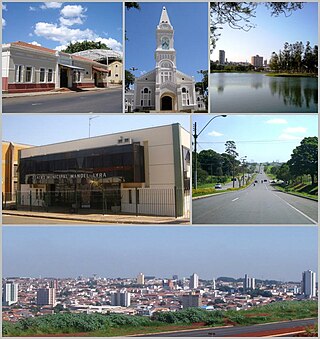
Limeira is a city in the eastern part of the Brazilian state of São Paulo. With a population of approximately 291,869 people and covering an area of 581 square kilometers, it sits at an elevation of 588 meters. The city is situated 154 kilometers from São Paulo, the capital of the state, and 1011 kilometers from Brasilia, the capital of Brazil. Limeira is conveniently accessible from São Paulo via two highways: Rodovia Anhanguera and Rodovia dos Bandeirantes.

Citrus production encompasses the production of citrus fruit, which are the highest-value fruit crop in terms of international trade. There are two main markets for citrus fruit:

Piracicaba is a city located in the Brazilian state of São Paulo. The population is 423,323 (2022) in an area of 1,378.07 km2. It is at an elevation of 547 m above sea level.

São Pedro is a municipality in the state of São Paulo in Brazil. The population is of 35,980 (2020) in an area of 611.278 km2 (236.02 sq mi).

Warwick Estevam Kerr was a Brazilian agricultural engineer, geneticist, entomologist, professor and scientific leader, notable for his discoveries in the genetics and sex determination of bees. The Africanized bee in the western hemisphere is directly descended from 26 Tanzanian queen bees accidentally released by one of his assistant bee-keepers. When reassembling a hive, the assistant forgot to install the queen excluder. This occurred in 1957 in Rio Claro, São Paulo in the southeast of Brazil from hives operated by Kerr, who had interbred honey bees from Europe and southern Africa.

The Instituto Agronômico de Campinas is a research and development institution affiliated to the Agência Paulista de Tecnologia dos Agronegócios, of the Secretary of Agriculture of the state of São Paulo, Brazil, with headquarters in the city of Campinas. It is the oldest institution of its kind in Latin America, having been founded by Emperor Dom Pedro II in 1887 as the Imperial Agronomical Station of Campinas. In 1892 it was transferred to the state government.

Santa Bárbara d'Oeste is a municipality in the State of São Paulo in Brazil. It is part of the Metropolitan Region of Campinas. It lies about 138 kilometres (86 mi) northwest of the State capital. It occupies an area of 272.2 square kilometres (105.1 sq mi), of which 43.1 square kilometres (16.6 sq mi) is urban. In 2020, the population was estimated at 194,390 by the Brazilian Institute of Geography and Statistics, making it the 43rd most populous city in São Paulo and the sixth largest in the metropolitan region of Campinas.

The Rodovia Luiz de Queirós is a highway in the state of São Paulo, Brazil.
Brazilian hemorrhagic fever (BzHF) is an infectious disease caused by Brazilian mammarenavirus, an arenavirus. Brazilian mammarenavirus is one of the arenaviruses from South America to cause hemorrhagic fever. It shares a common progenitor with Argentinian mammarenavirus, Machupo mammarenavirus, Tacaribe mammarenavirus, and Guanarito mammarenavirus. It is an enveloped RNA virus and is highly infectious and lethal. Very little is known about this disease, but it is thought to be transmitted by the excreta of rodents. This virus has also been implicated as a means for bioterrorism, as it can be spread through aerosols.

The Luiz de Queiroz College of Agriculture is a unit of the University of São Paulo involved with research, teaching and extension of services in agriculture, animal husbandry, agricultural and related sciences. The school's main campus, located in Piracicaba, São Paulo, is home to seven undergraduate and eighteen graduate programs. In addition, the school maintains exchange agreements with many other institutions of the world, and welcome exchange students of several nationalities.
Citrus leprosis(CL) is an economically important viral disease affecting citrus crops. This emerging disease is widely distributed in South and Central America, from Argentina to Mexico. The disease is associated with up to three different non-systemic viruses, which cause similar symptoms in the citrus hosts and are transmitted by the same vector, mites of the genus Brevipalpus; although they have vastly different genomes. Citrus leprosis virus nuclear type (CiLV-N) is found in the nuclei and cytoplasm of infected cells, while Citrus leprosis virus cytoplasmic type (CiLV-C) is found in the endoplasmic reticulum. In 2012, a new virus causing similar symptoms was found in Colombia and it was named Citrus leprosis virus cytoplasmic type 2 (CiLV-C2) due to its close similarity to CiLV-C. The cytoplasmic type viruses are the most prevalent and widely distributed of the three species.
Diedja Maglione Roque Barreto, commonly known as Didi, is a Brazilian football coach and former goalkeeper.

Romeu Italo Ripoli was an agronomist, businessman, politician and sports manager. He was president of the Esporte Clube XV de Novembro (Piracicaba), soccer team of the city.
Janaína Queiroz Cavalcante, known as Janaína or just Jana, is a Brazilian footballer. A centre-back, her strongest attributes are marking and heading.

Daiane Limeira Santos Silva, commonly known as Daiane Limeira or simply Daiane, is a Brazilian professional footballer who plays as a defender for American club Portland Thorns FC and the Brazil women's national team.
The following is a timeline of the history of the city of Águas de São Pedro, Brazil.

Marie Rennotte was a Belgian-born Brazilian physician, teacher, and women's rights activist. She was active in the fight for women's rights. After earning her teaching credentials in Belgium and France, Rennotte taught for three years in Germany before moving to Brazil as a governess. Giving private lessons and teaching at a girls' school, she lived in Rio de Janeiro from 1878 to 1882. Hired to teach in the State of São Paulo, she moved to Piracicaba where from 1882 to 1889 she taught science, developed the curriculum, and enhanced the reputation of the Colégio Piracicabano. The co-educational school was an innovative institution offering equal education to girls and boys.

Veridiana Valéria da Silva Prado, known as Dona Veridiana, was a Brazilian aristocrat, landowner and intellectual. She had a significant influence in social, political and cultural life of the city of São Paulo at the end of the Empire and the beginning of the First Republic.
Ana Maria Primavesi was an agronomist, researcher and educator of soil science and especially the ecological management of tropical Brazilian soil.
Karen Aline Peliçari, simply known as Karen, is a Brazilian footballer who plays for Cruzeiro. Mainly a forward, she can also play as an attacking midfielder.













